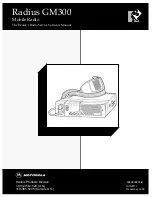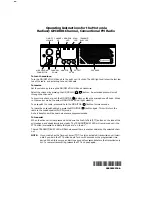
PRIMUS
R
660 Digital Weather Radar System
A28–1146–111
REV 2
Radar Facts
5-44
Step
Procedure
ÁÁÁÁ
ÁÁÁÁ
ÁÁÁÁ
ÁÁÁÁ
ÁÁÁÁ
ÁÁÁÁ
ÁÁÁÁ
ÁÁÁÁ
3
ÁÁÁÁÁÁÁÁÁÁÁÁÁÁÁÁÁÁ
ÁÁÁÁÁÁÁÁÁÁÁÁÁÁÁÁÁÁ
ÁÁÁÁÁÁÁÁÁÁÁÁÁÁÁÁÁÁ
ÁÁÁÁÁÁÁÁÁÁÁÁÁÁÁÁÁÁ
ÁÁÁÁÁÁÁÁÁÁÁÁÁÁÁÁÁÁ
ÁÁÁÁÁÁÁÁÁÁÁÁÁÁÁÁÁÁ
ÁÁÁÁÁÁÁÁÁÁÁÁÁÁÁÁÁÁ
ÁÁÁÁÁÁÁÁÁÁÁÁÁÁÁÁÁÁ
Any storm with reported tops at or greater than 20,000 feet
must be avoided by 20 NM.
WARNING
DRY HAIL CAN BE PREVALENT AT HIGHER ALTITUDES
WITHIN, NEAR, OR ABOVE STORM CELLS, AND SINCE
ITS RADAR REFLECTIVITY IS POOR, IT can NOT BE
DETECTED.
ÁÁÁÁ
ÁÁÁÁ
ÁÁÁÁ
ÁÁÁÁ
4
ÁÁÁÁÁÁÁÁÁÁÁÁÁÁÁÁÁÁ
ÁÁÁÁÁÁÁÁÁÁÁÁÁÁÁÁÁÁ
ÁÁÁÁÁÁÁÁÁÁÁÁÁÁÁÁÁÁ
ÁÁÁÁÁÁÁÁÁÁÁÁÁÁÁÁÁÁ
For brief periods use increased gain (rotate GAIN control
to its maximum cw position) when flying near storm tops.
This helps display the normally weaker returns that could
be associated with hail.
ÁÁÁÁ
ÁÁÁÁ
ÁÁÁÁ
ÁÁÁÁ
ÁÁÁÁ
ÁÁÁÁ
ÁÁÁÁ
ÁÁÁÁ
ÁÁÁÁ
ÁÁÁÁ
ÁÁÁÁ
ÁÁÁÁ
ÁÁÁÁ
5
ÁÁÁÁÁÁÁÁÁÁÁÁÁÁÁÁÁÁ
ÁÁÁÁÁÁÁÁÁÁÁÁÁÁÁÁÁÁ
ÁÁÁÁÁÁÁÁÁÁÁÁÁÁÁÁÁÁ
ÁÁÁÁÁÁÁÁÁÁÁÁÁÁÁÁÁÁ
ÁÁÁÁÁÁÁÁÁÁÁÁÁÁÁÁÁÁ
ÁÁÁÁÁÁÁÁÁÁÁÁÁÁÁÁÁÁ
ÁÁÁÁÁÁÁÁÁÁÁÁÁÁÁÁÁÁ
ÁÁÁÁÁÁÁÁÁÁÁÁÁÁÁÁÁÁ
ÁÁÁÁÁÁÁÁÁÁÁÁÁÁÁÁÁÁ
ÁÁÁÁÁÁÁÁÁÁÁÁÁÁÁÁÁÁ
ÁÁÁÁÁÁÁÁÁÁÁÁÁÁÁÁÁÁ
ÁÁÁÁÁÁÁÁÁÁÁÁÁÁÁÁÁÁ
ÁÁÁÁÁÁÁÁÁÁÁÁÁÁÁÁÁÁ
When flying at high altitudes, tilt downward frequently
to avoid flying above storm tops.
Studies by the National Severe Storms Laboratory (NSSL)
of Oklahoma have determined that thunderstorms
extending to 60,000 ft show little variation of turbulence
intensity with altitude.
Ice crystals are poor reflectors. Rain water at the lower
altitudes produce a strong echo, however at higher
altitudes, the nonreflective ice produces a week echo as
the antenna is tilted up. Therefore, though the intensity of
the echo diminishes with altitude, it does not mean the
severity of the turbulence has diminished.
NOTE:
If the TILT control is left in a fixed position at the higher flight
levels, a storm detected at long range can appear to become
weaker and actually disappear as it is approached. This occurs
because the storm cell that was fully within the beam at 100 NM
gradually passes out of and under the radar beam.
ÁÁÁÁ
ÁÁÁÁ
ÁÁÁÁ
ÁÁÁÁ
ÁÁÁÁ
ÁÁÁÁ
ÁÁÁÁ
ÁÁÁÁ
6
ÁÁÁÁÁÁÁÁÁÁÁÁÁÁÁÁÁÁ
ÁÁÁÁÁÁÁÁÁÁÁÁÁÁÁÁÁÁ
ÁÁÁÁÁÁÁÁÁÁÁÁÁÁÁÁÁÁ
ÁÁÁÁÁÁÁÁÁÁÁÁÁÁÁÁÁÁ
ÁÁÁÁÁÁÁÁÁÁÁÁÁÁÁÁÁÁ
ÁÁÁÁÁÁÁÁÁÁÁÁÁÁÁÁÁÁ
ÁÁÁÁÁÁÁÁÁÁÁÁÁÁÁÁÁÁ
ÁÁÁÁÁÁÁÁÁÁÁÁÁÁÁÁÁÁ
When flying at low altitudes rotate tilt upward
frequently to avoid flying under a thunderstorm.
There is some evidence that maximum turbulence exists at
middle heights in storms (20,000 to 30,000 ft); however,
turbulence beneath a storm is not to be minimized.
However, the lower altitude can be affected by strong
outflow winds and severe turbulence where thunderstorms
are present. The same turbulence considerations that
apply to high altitude flight near storms apply to low
altitude flight.
Severe Weather Avoidance Procedures
Table 5–9 (cont)
Содержание PRIMUS 660
Страница 1: ...AD 54257 ...
















































